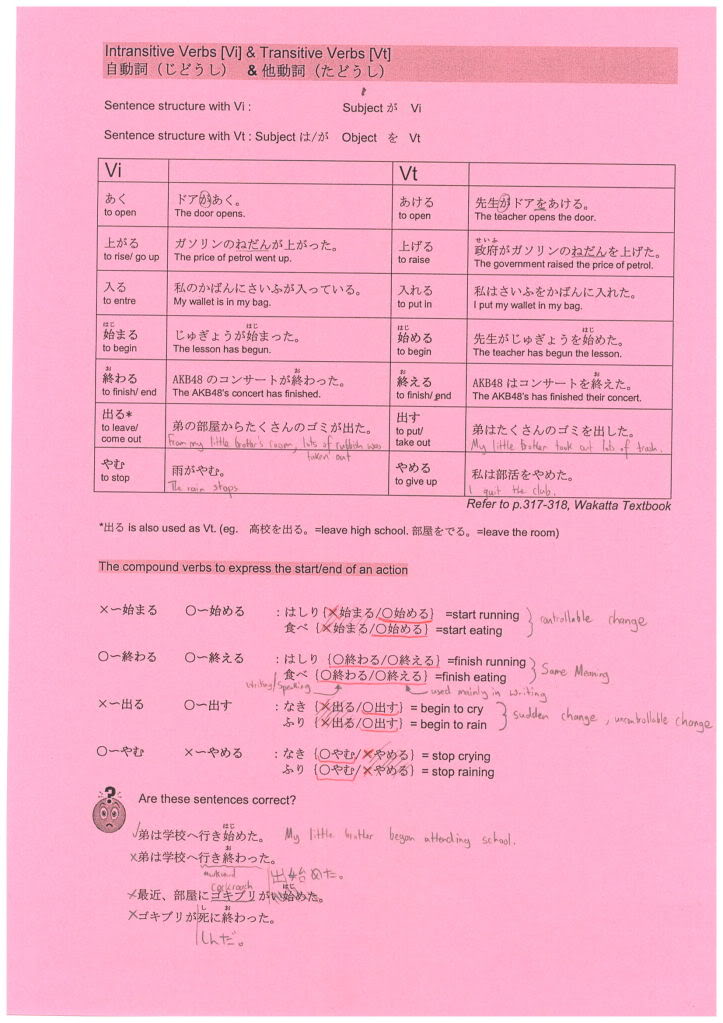LieAnn wrote:
First question:
It's about the combination of verbs. According to lessons, a verb should be in い form to be able to combine it to another verb. For example:
Now my question is, what should be the form of the new verb? And can you please give some examples of combined verbs 'cause I honestly can't think of any. ありがとうございます!あう >>> あい + New Verb
Basic Form >>> Change う to い then add the new verb
I'll try help a bit,
the " いform" of the verb is known as the verb stem. The sound does not always end in い. For example, when you have a word like たべます, to find the stem you drop ます, so たべ is the stem, and similarly the stem of はしります (to run) is はしり.
I don't know combined verbs as a native speaker would, but for learners the ones I have been taught that are added to the Verb Stem are:
1. Verb Stem~はじめる* (to start) eg: はしりはじめる (to start running)
* はじめる, is used for a controllable change,
For a sudden or uncontrollable change you use
Verb Stem~だす
eg: 雨がふりだした。(It suddenly began to rain, notice が, ~だす is always used with が)
In the 'start running' example, if you wanted to suggest that you were being chased or were running away from something then you could use: はしりだす
2. Verb Stem~つづける (to continue) eg:べんきょうしつづける (to continue studying)
3. Verb Stem~おわる (to finish) eg: たべおわる (to finish eating)
4. Another one I know is Verb Stem + すぎる, which is used to indicate that you have done something too much.
eg: しんぱいすぎる (to worry too much) or たべすぎた (ate too much)
This is the Verb Stem + ながら pattern, the order of the the verbs depends on which action is more important. The secondary verb is added to ながら.
Second question:
It's about the "while (verb)" thing. Again, according to lessons I found on the net:
My question is about the pattern of the sentence, for example I want to translate this sentence:わらう >>> わらい + ながら >>> わらいながら means "while laughing"
Basic Form >>> Change う to い + ながら
Which verb comes first?She is dancing while laughing.
In your example, i'll say dancing is the primary (more important) action so the secondary action is laughing therefore it'll be:
かのじょはわらいながら、おどっている。(She is dancing while laughing, or literally While laughing, she is dancing)
Another example would be:
Ipod を ききながら、しゅくだいをする。(While listening to my Ipod, I do my homework)
Doing homework is the primary action, therefore ながら is added to listening.
If you wanted to make it seem that you weren't really doing homework and were mainly listening to your Ipod, then you would swap the verbs around.
Hope that helps, If you want I could scan some of the notes/handouts my Japanese teacher gave on these two grammars (or others which I have learnt), they are quite detailed.
































 YES WAY!!! I WANNA LEARN JAPANESE TOO!!! THANKS DUDE, UR AWESOME! .smile. I only know a phew phrases. BTW, how do ya rite in japanese in the PC?! (noob)...
YES WAY!!! I WANNA LEARN JAPANESE TOO!!! THANKS DUDE, UR AWESOME! .smile. I only know a phew phrases. BTW, how do ya rite in japanese in the PC?! (noob)... .whistle.
.whistle. 

